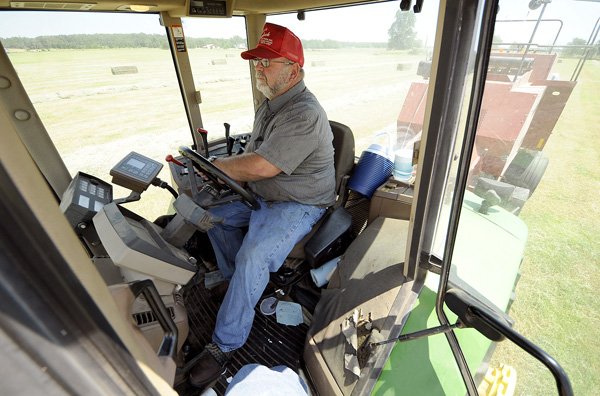NORTHWEST ARKANSAS — Cattlemen from Lincoln to Maysville are hoping for a soaking rain soon to get a second hay cutting to bolster tight supplies.
Ronnie Magee has about 400 cows on his Decatur farm and estimates hay production has been about 70 percent of normal volume.
A long cold winter left little to no carryover from last year’s hay crop, according to Robert Seay, cooperative extension agent for Benton County. He said the short crop this year will mean some farmers who have been trying to increase herd sizes may have to sell cattle.
High temperatures, brisk winds and the lack of moisture in June and now in July are burning up what would be a second hay cutting, which Seay said will be needed to feed cattle through the winter.
“It’s feast or famine - bankrupt one day and knee deep in high cotton the next,” Magee said. “It rained so much early that it delayed the first cutting and there’s been little to no moisture to speak of since. I still have some pasture fit for grazing so I am not crying yet, but we sure need a good rain.”
Magee doesn’t plan to sell any cattle, but said without enough hay, the sale barn is the best solution for some farmers because of higher cattle prices this year. He put up 1,700 bales in his first cutting, but said he walked the fields and there was nothing else to cut unless some moisture is coaxed out of the clouds soon.
Jim Singleton, chairman for the Benton County Quality Forage program, said the cool season fescue was cut late because of the spring floods, which resulted in about 30 percent less volume and a lower forage quality across the county.
“I don’t know anybody who has an adequate hay supply to carry them through the winter,” Singleton said. “We are going to need another cutting andthat requires soaking rain, not just sprinkles to settle the dust.”
Ozzie Rodgers of Decatur operates a commercial Bermuda hay business and estimates his first cutting was off about 40 percent of his normal volume of 5 tons per acre. Rodgers said he went to the expense of fertilizing his fields.
Vernon Schmiegelow of Hiwasse said he also fertilized his Bermuda fields andbaled early which gave him a fairly normal supply at the first cutting.
“I am about a week or so away from a second cutting and could use a good rain. The hot southwest winds and 90-degree days have sucked the moisture out, which are frying the fields,” Schmiegelow said.
He sold off about 50 head of cattle earlier this year in part because of the droughtthat persisted from May 2010 until this April, when 2 feet of rain inundated the region.
“This extreme weather has wreaked havoc on our hay fields,” said Connie Yell, who raises registered Angus cattle and poultry near Lincoln. “Early this spring torrential rains flooded four of our eight pastures. Water rose 21 feet into the trees depositing a thick muddysilt and heavy debris that left us with a 50 percent reduction in hay.”
She ended up buying a large portion of hay from another farmer near Morrow whose pastures are on higher ground, she said.
“We didn’t wait around, we got online early, went to his farm and bought it while it was still growing in the fields,” Yell said. “It costs us $30 a round bale, delivered.Bermuda has been going as high as $50 a round bale before hauling costs since then. We have gotten about 200 bales so far.”
She estimated yielding about 100 bales on her farm compared to 250 in a normal year.
“It will take about 600 bales to get us through the winter,” Yell said. “My cows are standing in dust, we sure need a good rain.”
News, Pages 9 on 07/13/2011

